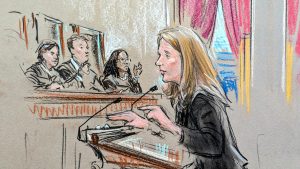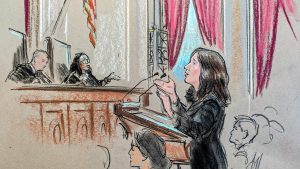[ad_1]
ARGUMENT ANALYSIS
on Feb 21, 2024
at 3:50 pm
The 4 consolidated challenges to an EPA air air pollution rule, fast-tracked off the justices’ emergency docket in December, headlined Wednesday’s arguments. (Katie Barlow)
The Supreme Court docket on Wednesday appeared sympathetic to a bunch of states, firms, and commerce associations in search of to briefly block a rule issued by the Environmental Safety Company to scale back air air pollution from energy crops and different industrial amenities in 23 states that don’t wish to modify their emissions insurance policies. Throughout roughly 90 minutes of oral arguments, the courtroom’s conservative justices voiced skepticism in regards to the course of that the EPA adopted in implementing the rule, whereas the courtroom’s liberal justices questioned the knowledge of placing the rule on maintain earlier than any decrease courtroom has had an opportunity to weigh in.
The regulation on the middle of the case is called the “good neighbor” provision of the Clear Air Act. It requires “upwind” states to scale back emissions that have an effect on the air high quality in “downwind” states.
In 2015, the EPA issued new air-quality requirements for ozone air pollution, which at excessive ranges may cause main well being issues. The brand new EPA requirements triggered an obligation for states to submit plans to point each how they might adjust to these requirements and, particularly, how they would cut back emissions that have an effect on the air high quality in downwind states.
The dispute on the middle of this case arises from the EPA’s determination final 12 months to reject the plans submitted by 21 states, which had not proposed any modifications to their emissions plans. One month after throwing out the state plans, the EPA printed its personal plan for these states, in addition to for 2 different states that had not submitted plans.
Earlier than the EPA’s plan might go into impact final August, three states — Ohio, Indiana, and Virginia, went to the U.S. Court docket of Appeals for the District of Columbia Circuit to problem it, as did a number of firms and commerce associations additionally affected by the plan.
When a divided D.C. Circuit denied the challengers’ request to dam the plan whereas litigation continued, the challengers got here to the Supreme Court docket with an emergency enchantment, on what is typically known as the courtroom’s “shadow docket.” In December, the justices fast-tracked the case for oral argument on Wednesday.

Ohio Solicitor Basic Mathura Sridharan argues for the state. (William Hennessy)
Representing the states, Ohio Solicitor Basic Mathura Sridharan argued that the method by which the EPA had arrived at its federal plan was flawed. Particularly, she contended, 12 states had gone to courtroom to problem the EPA’s rejection of their plans, and a number of other courts of appeals have put these rejections on maintain, precluding the EPA from imposing its federal plan on these states.
However the EPA’s plan, Sridharan defined, relied on the belief that every one 23 states would take part within the federal plan. As soon as it turned clear that not all states can be a part of the plan, she informed the justices, the EPA want to contemplate what the impact of less-than-full participation would have.
The EPA’s failure to take action, Sridharan continued, “has change into consequential,” as a result of the EPA’s plan “now regulates underneath half of the states and 1 / 4 of the emissions that the EPA initially got down to regulate.”
Catherine Stetson, representing firms that personal and function pure gasoline pipeline engines, emphasised that “the aim of the ‘good neighbor’ provision is to scale back the numerous contribution that upwind states make to downwind states” – not merely to guard downwind states. Due to this fact, she reasoned, the EPA ought to have examined whether or not, with solely 11 states topic to the federal plan, “there would nonetheless be a major contribution” to downwind air high quality.

Catherine Stetson argues for the pipeline engine firms. (William Hennessy)
Stetson added that, if the rule is allowed to stay in impact, it might imply “a whole lot of hundreds of thousands if not billions of {dollars} in prices over the following 12 to 18 months.” In contrast, she recommended, there’s not a “very, very vital downwind downside” however as an alternative a “minuscule” one.
Deputy U.S. Solicitor Basic Malcolm Stewart, representing the EPA, pushed again towards any suggestion that the EPA had failed to contemplate what may occur if some states weren’t finally topic to the federal plan. As a substitute, he insisted, “EPA anticipated from the outset that the plan was one whose geographic composition might change,” and the company “devised the necessities for every state so that they might be workable if a smaller or a bigger set of states had been finally coated.”

Deputy U.S. Solicitor Basic Malcolm Stewart argues for the EPA. (William Hennessy)
Furthermore, Stewart added, even when the federal plan solely at the moment applies to 11 states, slightly than 23, “the necessities which can be imposed on sources are precisely the identical as would have been imposed on sources in these 11 states if the complete plan had been applied,” and the 11 states are nonetheless offering the advantages of diminished air air pollution.
However the courtroom’s conservative justices had been unpersuaded by Stewart’s characterization of the method that EPA used. Justice Brett Kavanaugh was essentially the most brazenly sympathetic to the challengers. He repeatedly noticed that the EPA had been informed that the rejections of the state plans can be “problematic” and “would unravel the entire” federal plan. However the EPA merely indicated, Kavanaugh emphasised, that even when the plan didn’t apply to some states, it might nonetheless be applied for the remaining states, with out offering the sort of rationalization about how the revised plan would work that the federal legal guidelines governing administrative companies require.
Justice Neil Gorsuch echoed Kavanaugh’s considerations. He informed Stewart that the EPA had “initially proposed a 23-state answer” however then obtained feedback warning that not all 23 states would essentially be topic to the plan. The EPA responded, he famous, by indicating that the plan would nonetheless stay in pressure even when some states had been exempted from it. However “no one acquired a possibility to touch upon that,” mentioned Gorsuch, as federal regulation may require.
Chief Justice John Roberts pressed Stewart to say when, if the plan had been allowed to stay in impact, the EPA would tackle the impact of the change within the variety of states coated by the plan.
Stewart indicated that the EPA didn’t essentially “have any plan to do this,” each as a result of the company had already analyzed the broader image and due to the prospect that the EPA might finally prevail in among the challenges to its rejections of state plans. For instance, he mentioned, final week the U.S. Court docket of Appeals for the tenth Circuit transferred challenges by Utah and Oklahoma to the D.C. Circuit, which “might lead to Utah and Oklahoma being put again into the federal plan.”
However Roberts appeared unhappy by that response, suggesting to Stewart that the sharp discount within the quantity of emissions coated by the federal plan was “one thing new” that the EPA ought to think about. “And when it comes to why it’s obligatory to take a look at this right here,” Roberts continued, “when you assume it’s an vital query, it’s as a result of EPA is not going to take a look at it till after the a whole lot of hundreds of thousands of {dollars} of prices are incurred.”

New York Deputy Solicitor Basic Judith Vale representing the state. (William Hennessy)
Justice Elena Kagan recommended that the challengers had been imposing too excessive a bar on the EPA. As soon as it turned conscious of the prospect that some states could be exempt from the federal plan, she requested Sridharan, was the company required to contemplate each potential mixture of the 23 states. There are, she noticed, “like 4 million totally different permutations. What was the EPA speculated to do?”
However the liberal justices’ major goal was as an alternative what they characterised as the weird procedural posture through which the dispute got here to the courtroom. If the courtroom had been to place the EPA’s federal plan on maintain in these circumstances, they repeatedly contended, it will successfully open the door for the courtroom to change into a discussion board of first resort each time somebody desires to problem a federal rule.
Justice Ketanji Brown Jackson informed Sridharan that it was, in her view, “pretty extraordinary … to be asking the Court docket to resolve this matter if you haven’t even” briefed, a lot much less misplaced, the case within the D.C. Circuit but. Pointing to the compliance deadline of 2026 she mentioned, “So I’m making an attempt to know what the emergency is that warrants Supreme Court docket intervention at this level.” And he or she recommended that, in circumstances like this, the Supreme Court docket ought to require candidates just like the challengers to indicate “extraordinary hurt” earlier than placing a federal rule on maintain.
Jackson made her level much more clearly a couple of minutes later, telling Sridharan that “what I’m a bit involved about is that actually your argument is simply boiling all the way down to we predict we’ve a meritorious declare and we don’t wish to should comply with the regulation whereas we’re difficult it. And I don’t perceive why each single one who is difficult a rule doesn’t have the identical set of circumstances.”
Justice Sonia Sotomayor additionally voiced objections to the method by which the dispute was earlier than the courtroom. She recommended that it was an “inversion of regular guidelines” for the challengers to attempt to “bypass the very courtroom who’s going to make the substantive determination,” notably when the states had not requested the D.C. Circuit to fast-track the proceedings.
Kagan expressed comparable considerations. In response to Sridharan’s insistence {that a} key problem within the case is “the EPA failed to contemplate within the first occasion what occurs when there’s lesser participation” within the federal plan, Kagan reiterated that some states might ultimately lose their challenges to the EPA’s rejection of the state plans. And if that’s the case, she continued, “the thought that you could be right here and demanding emergency reduction simply because states have kicked up plenty of mud appears not the proper reply to me.” However the remainder of the courtroom didn’t appear to share the liberal justices’ misgivings, a promising signal for the challengers.
A call is anticipated by summer season.
This text was originally published at Howe on the Court.
[ad_2]
Source link

